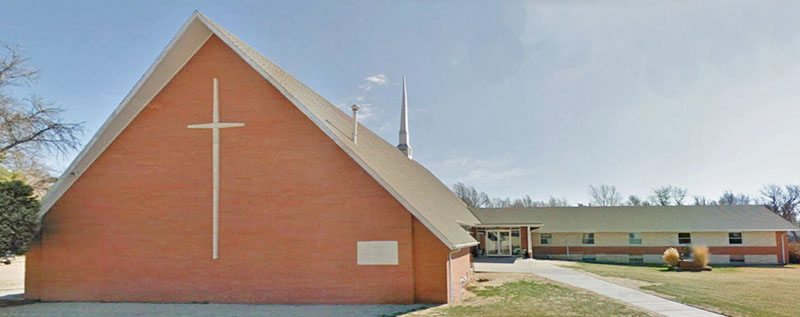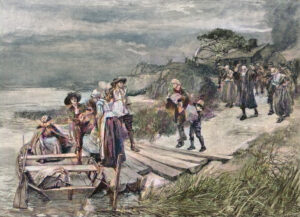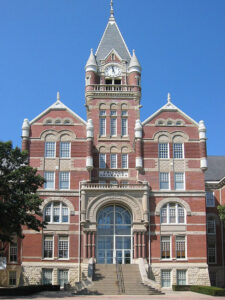The religious order known as Friends, more commonly called Quakers, originated in England around 1647. The society’s founder was George Fox, a dissenter from the teachings and practices of the church of that period. His views and practical application of Christian doctrines spread rapidly, and within a short time, he had many adherents. These people had no intention of establishing a new church, but as their preaching was incompatible with the church’s practices, it was inevitable that separation should follow. Fox preached in central England first, and from that region, some 60 Quaker missionaries carried on the new movement. The members were variously known as Children of Truth, Friends of Truth and finally the name Religious Society of Friends was adopted.
The friends have no formal creed or doctrine, and it is in spirit more than faith that they differ from other denominations. The first disciplinary meetings, established as early as 1856, were held monthly and were congregational. By the term discipline, the Friends understand all regulations and arrangements for the civil and religious benefit of the church. Gradually certain meetings or assemblies were established and are now four in number: preparatory, monthly, quarterly and yearly meetings. The preparatory meetings are subordinate to the monthly meetings and have little power, being occupied with local affairs and have been discontinued in America. Each other meeting is subordinate to the one above, up to the yearly meeting with exclusive legislative power.
The Quaker movement spread to Scotland and Ireland and in the middle of the 17th century to America. The first Friends who settled in the Massachusetts colony were persecuted and deported, but despite this, converts and meetings were established in the English colonies. The Friends who came to New Jersey settled along the Raritan River and founded Burlington: William Penn joined the society in 1667. He secured East Jersey and Pennsylvania; through his efforts, his colony had a Quaker population of 7,000 within three years. As early as 1688, the Friends protested against slavery, and no slaves were in their possession after the year 1787. Since the establishment of the Friends in America the organization has divided into the following bodies: Society of Friends (Orthodox), Religious Society of Friends (Hicksite), Orthodox Conservative Friends (Wilburite), and Friends Primitive.
With the great migratory movement west after the American Revolution, Quakers passed into the Ohio and Mississippi River valleys. By the 20th century, their faith had been carried to the shores of the Pacific Ocean.
In 1834 they founded a mission among the Shawnee Indians of Kansas, near the Methodist mission on the Neosho River, where in 1854, David Thayer and his wife and Richard Mendenhall had charge of the mission and school for the Indian children. Some of the first Quaker settlers of Kansas were William H. Coffin, B. H. Hiatt and Eli Wilson, who came to the territory in the fall of 1854, and located the first Friends settlement on Fall creek about 14 miles west of Leavenworth. The first Friends meeting was held in February 1856, which was probably the first Friends meeting in Kansas Territory outside of the Friends mission. This was at Benjah Hiatt’s cabin on Fall Creek about a mile above its confluence with Stranger creek. After this, meetings were held regularly.
In December 1857, there being about 50 Quakers in the settlement, they sent a request to the Milford monthly meeting of Indiana to have a preparatory meeting, and a committee was sent from Milford in May 1858 to attend the opening. Many more Friends came to Kansas in the spring and in the summer of 1859, and the first Friends meeting-house in Kansas was built. A second and quite large settlement of Friends had been formed on the Cottonwood River, near Emporia, and a third south of Osawatomie, where meetings were held soon after the Battle of Osawatomie in 1856. Immigrants formed other settlements of Friends from the east. Some of the earliest were near Lawrence, where a church was organized in 1865. This was the nucleus of the yearly meeting afterward held there. The first census that gave a report of the Friends’ organizations in Kansas was that of 1882, when there were 43 organizations, 26 church edifices, and a membership of 4,774, with church property valued at $43,700. This was followed by a rapid increase, for in 1886 there were 53 organizations, 46 churches and a membership of 6,300. During the following eight years, the organizations increased to 95, there were 85 church edifices, a membership of 9,133, and the church had grown so that there were thirteen quarterly meetings represented at the yearly meeting. By 1910, there were 14 quarterly meetings in the annual meeting, but two of these included some congregations in Oklahoma and Missouri. The membership remained about the same in Kansas as the emigration to other states has about equaled the increase.
©Kathy Alexander/Legends of Kansas, updated March 2024.
Also See:



